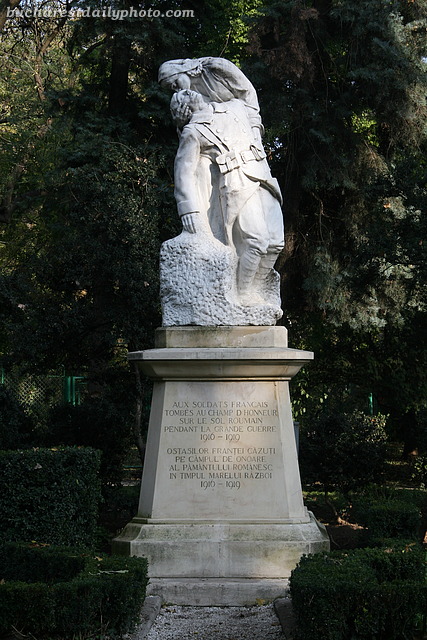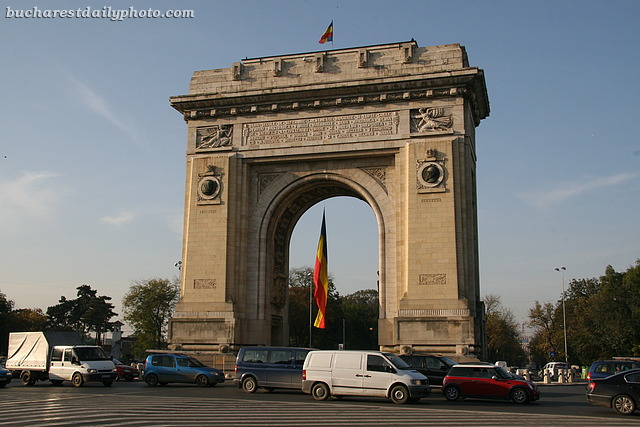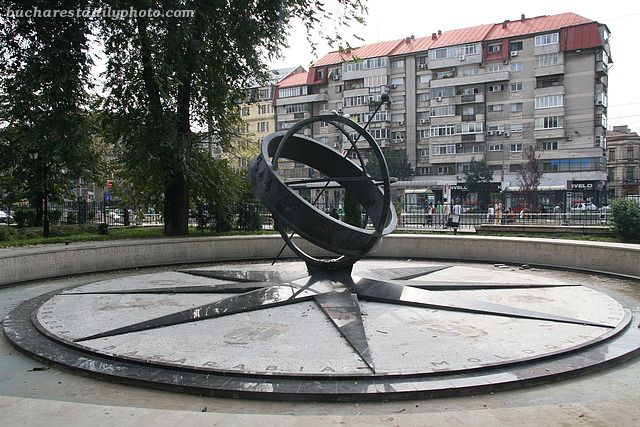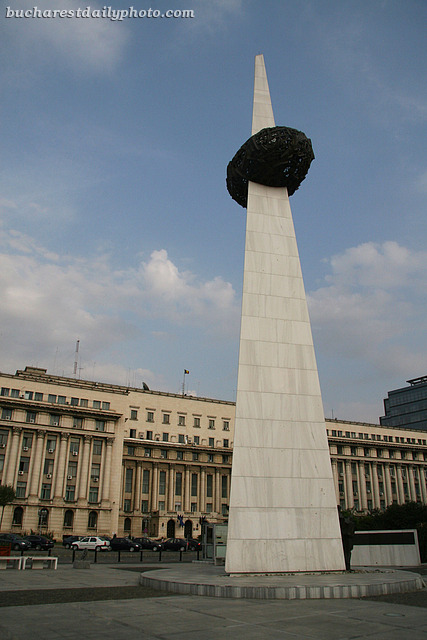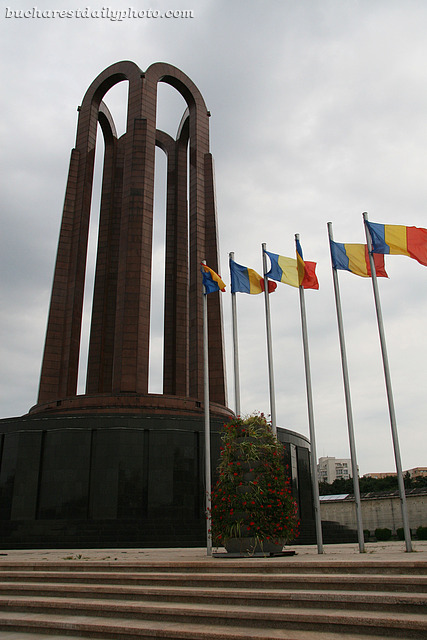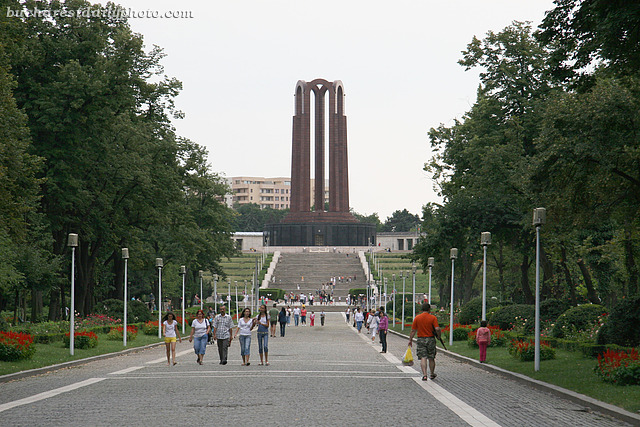Today’s photo shows another beautiful sculpture in Cişmigiu Park, the Monument of the French Soldiers, which honors the French soldiers who died on Romanian soil during the First World War. It seems to be the most popular monument in the park cause every time I pass by I see people taking pictures of it. It depicts a French soldier dying in the arms of a Romanian peasant woman. It was unveiled in October 1922 in the presence of French Marshal Ferdinand Foch. The sculptor Ion Jalea, a war veteran himself, was awarded the “National Order of the Legion of Honour”, the highest decoration in France.
Bucharest’s Triumphal Arch (Arcul de Triumf in Romanian) lies in a very busy intersection in northern Bucharest. Designed by the architect Petre Antonescu, the structure was erected in 1935-1936 to commemorate the creation of Greater Romania which took place in 1918. This arch is the third triumphal arch built in Bucharest. The first arch made of wood and cardboard was erected in a rush in 1878 to mark Romania’s independence from the Turks. Victorious troops marched under it on their arrival in Bucharest. This first arch was replaced by a second one, located on the same spot as the current arch and also designed by Petre Antonescu. It was erected in 1922 to mark Ferdinand’s entry into Bucharest as the first king of Greater Romania. In 1935 the arch was in pretty bad shape so it was thoroughly renovated and became the structure that we see today, built of concrete and granite. Portraits of King Ferdinand and Queen Marie decorate one face, while the names of battles fought by Romanians during the First World War can be seen on the other face. The portraits of the king and queen were removed during the communist rule but they were readded in 1992. The sculptures decorating the arch were created by leading artists of the day, including Ion Jalea, D. Onofrei and Constantin Baraschi. Sometimes, on special occasions, the arch is open for visitation.
In the last few years Bucharest’s Triumphal Arch became the site of a strange wedding ritual which I won’t tell you about right now, on the hope that one of these days I’ll make a photo that would better tell the story. If you’re really curious and want a sneak peak just follow these youtube links: one and two.
One thing I like about keeping this blog – aside from the good excuse to walk the city and take photos – is the documentation work that I do before I write about a subject. I get to find out many interesting things about the history of Bucharest, events I didn’t imagine happened. I started to read about the history of Bucharest a few years ago but every day I keep discovering new things; I guess that’s normal for a city of this size and with 550 years of history behind it. To give you an example, who would think that such a benign looking monument as is the one in today’s photo has an interesting story?
The monument in the photo marks Romania’s Kilometer Zero. For those not familiar with the concept, in many countries Kilometer Zero or Zero Milestone is a location (usually in the country’s capital) from which all road distances are measured. It is also customary that this spot is signaled by a marker or a monument. The Kilometer Zero of Romania is located in downtown Bucharest in front of New Saint George Church. And the story behind it is as follows. In the beginning of 1937 the city hall decided to erect a monument on this spot, marking Kilometer Zero. The “Military Stone” was supposed to be ready until May 9th 1937. In reality the monument was not finished by that date and its inauguration took place more than half a century later, in 1998. The monument was supposed to include a circular stone basin with a wind rose and in between the spokes of the rose were supposed to be mosaics with the names and the coats of arms of the Romanian provinces. In the center of the monument the artist imagined a sphere and on top of the sphere the statue of Saint George killing the dragon. After initially agreeing with the project the Romanian Church changed its mind and opposed the statue invoking the second commandment, which for the Orthodox church is “You shall not make for yourself an idol”. The sculptor, Constantin Baraschi, changed the project and instead of the statue of Saint George he proposed that the sphere carries the statue of – are you ready for this? 🙂 – Prince Charming killing the dragon. Still the project is rejected and before further changes were made the war started. After the end of the war the provinces of Bessarabia and Bukovina remained under Russian control and their coats of arms and names could not be admitted on the monument so the sphere was taken away and after 1950 the monument was covered with earth. The project was reinitiated only after 1990 when the basin and the wind rose were dug up. In the center of the monument there’s only a metallic zodiac sphere; nobody’s killing the dragon on top of it or anywhere close by. The monument was inaugurated on June 9th 1998, 61 years after its deadline. The historical provinces of Bessarabia and Bukovina do appear on the monument even though they are not part of Romania anymore. Also, among the cities inscribed on the stone basin are also Chişinău, Orhei, Tighina, which are currently in the Republic of Moldova, as well two towns now part of Bulgaria but which were part of Greater Romania from 1913 to 1940.
Wow, this was a loooong post. But I though the story was interesting and worth telling. I hope that in our ADD driven world someone will be patient enough to read it 🙂 – or rather someone will have the time to read it. I would also like to give credit to a fantastic book (unfortunately from what I know, available only in Romanian) in which I read most of the story told here. The name of the book is “Bucharest in dates and events” by Radu Olteanu.
Nobody in Bucharest (besides its author) seems to like this monument which was added to the Revolution Square in 2005. Even though its official name is “The Rebirth Memorial Eternal Glory to the Romanian Revolution and Its Heroes from December 1989”, the citizens of Bucharest refer to it by various names including “potato on a stick” (the most common one) or “the donut/nut/meatball on a spike”, “the olive on a toothpick”, “the brain skewered on a spike” etc. Apparently its modern design has not appealed at all to the citizens of Bucharest. It is so controversial that last year some of the candidates for the seat of mayor of Bucharest declared that in case they will be elected they will move or demolish the monument.
And another (more patriotic) shot of the mausoleum.
What does a citizen of Bucharest do if it’s nice outside and it’s a Sunday? A lot of them are heading for one of the city’s parks to chill in the shade on a wooden bench, talk to friends, play some volleyball, walk hand in hand with their sweethearts, play with other kids (if we’re talking about the little citizens), listen conversations of their neighbourgs, watch the old people play chess, rent a boat, check out other people’s outfits, drink a beer if there’s a beer garden nearby (there always is one), take pictures (like myself), rollerblade or ride the bicycle, jogg, walk the dog (if it’s allowed), feed the geese or swans or ducks, smell the flowers etc. Today’s photo shows the central alley in Carol Park on a Sunday. And as an added bonus, aside from the greenery and the people, there’s something else for you to enjoy in the picture: a piece of communist architecture, the mausoleum built in the honor of … hold your breath … “the heroes who fought for the freedom of the people and of the motherland and for socialism”. You can breathe now. I’m not kidding, that was the name of the monument during the communist regime. It was built in 1963 and until 1991 it housed the remains of many communist leaders. Nowadays the mausoleum contains the remains of soldiers fallen in WWI and has been dedicated to the Unknown Soldier. In front of it there’s a small monument flanked by guards where an eternal flame is burning.
